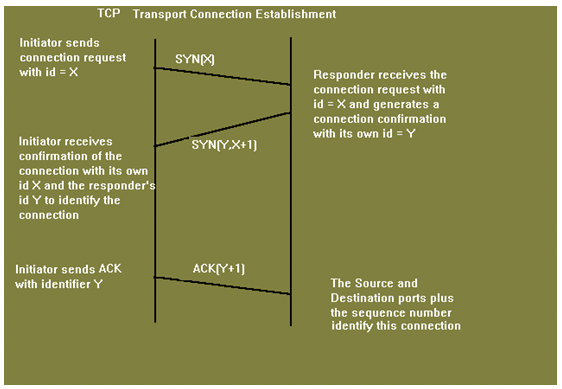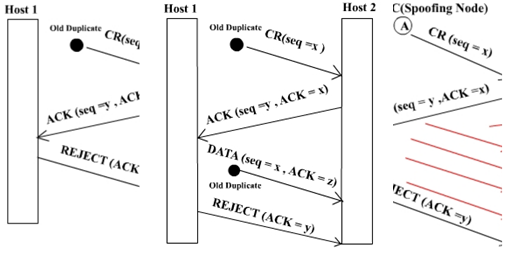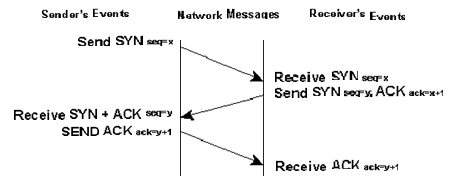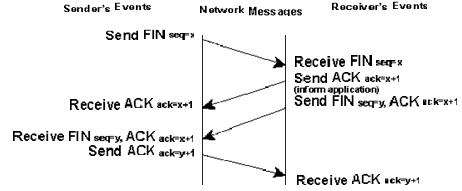TCP Connection establishment
The "three-way handshake" is the procedure used to establish a connection. This procedure normally is initiated by one TCP and responded to by another TCP. The procedure also works if two TCP simultaneously initiate the procedure. When simultaneous attempt occurs, each TCP receives a "SYN" segment which carries no acknowledgment after it has sent a "SYN". Of course, the arrival of an old duplicate "SYN" segment can potentially make it appear, to the recipient, that a simultaneous connection initiation is in progress. Proper use of "reset" segments can disambiguate these cases.
The three-way handshake reduces the possibility of false connections. It is the implementation of a trade-off between memory and messages to provide information for this checking.
The simplest three-way handshake is shown in figure below. The figures should be interpreted in the following way. Each line is numbered for reference purposes. Right arrows (-->) indicate departure of a TCP segment from TCP A to TCP B, or arrival of a segment at B from A. Left arrows (<--), indicate the reverse. Ellipsis (...) indicates a segment which is still in the network (delayed). TCP states represent the state AFTER the departure or arrival of the segment (whose contents are shown in the center of each line). Segment contents are shown in abbreviated form, with sequence number, control flags, and ACK field. Other fields such as window, addresses, lengths, and text have been left out in the interest of clarity.
TCP A TCP B
1. CLOSED LISTEN
2. SYN-SENT --> <SEQ=100><CTL=SYN> --> SYN-RECEIVED
3. ESTABLISHED <-- <SEQ=300><ACK=101><CTL=SYN,ACK> <-- SYN- RECEIVED
4. ESTABLISHED --> <SEQ=101><ACK=301><CTL=ACK> --> ESTABLISHED
5. ESTABLISHED --> <SEQ=101><ACK=301><CTL=ACK><DATA> --> ESTABLISHED
Basic three-Way Handshake for Connection Synchronisation
In line two of above diag. TCP A begins by sending a SYN segment indicating that it will use sequence numbers opening with sequence number hundred. In line three, TCP B sends a SYN and acknowledges the SYN it getting from TCP A. Here we have to note that the acknowledgment field indicates TCP B is now expecting to hear sequence one hundred one, acknowledging the SYN which occupied sequence hundred.
At line four TCP A reply with an drain segment containing an ACK for TCP B's SYN; and in line five, TCP A sends some data. Note that the sequence number of the section in line five is the same as in line four since the ACK does not occupy sequence number space (if it did, we would wind up ACKing ACK's!).

concurrent initiation is only to some extent more difficult, as is shown in diag. below. Each TCP cycles from CLOSED to SYN-SENT to SYN-RECEIVED to ESTABLISHED.
TCP(transmission control protocol) A TCP B
1. CLOSED LISTEN
2. SYN-SENT --> <SEQ=100><CTL=SYN> --> SYN RECEIVED
3. ESTABLISHED <-- <SEQ=300><ACK=101><CTL=SYN,ACK> «-- SYN RECEIVED
4. ESTABLISHED --> <SEQ=101><ACK=301><CTL=ACK> --> ESTABLISHED
5. ESTABLISHED --> <SEQ=101><ACK=301><CTL=ACK><DATA> --> ESTABLISHED
Fundamental three-Way Handshake for Connection Synchronization
Problem regarding two-way handshake
The one and only real problem with a two-way handshake is that duplicate packets(message) from a previous connection( which has been closed) among the 2 nodes might still be floating on the network. After a SYN has been sent to the responder, it may receive a carbon copy packet of a previous connection and it would regard it as a packet from the present connection which would be unwanted. Once more spoofing is another issue of concern if a 2 way handshake is used.let there is a node C which sends connection request to B saying that it is A.Now B sends an ACK to A which it discards & asks B to close connection. Among these 2 events C can send a lot of packets(message) which will be delievered to the application..

The 1st 2 figures show how a 3 way handshake deals with problems of duplicate or delayed connection requests and duplicate or delayed connection acknowledgements in the network.The three diag. highlights the problem of spoofing associated with a 2 way handshake.
Some Conventions
1. The ACK contains 'x+1' if the sequence number received is 'x'.
2. If 'ISN' is the sequence number of the connection packet then first data packet has the seq number 'ISN+1'
3. Seq no. are thirty two bit.They are byte seq number(each byte has a seq no.).Through a packet first seq number and length of the packet is sent.
4. Acknowledgements are cumulative.
5. Acknowledgements have a seq number of their own but with a length zero. So the next data packet have the sequence number same as ACK.
Connection Establishment

- The sender sends a SYN packet with sequence number say 'x'.
- The receiver on getting SYN packet responds with SYN packet with sequence no. 'y' and ACK with seq number 'x+1'
- On receiving both SYN and ACK packet, the sender replys with ACK packet with seq number 'y+1'
- The receiver when gets ACK packet, initiates the link.
Connection Release

- The initiator sends a FIN with the current seq and acknowledgement no.
- The responder on getting this informs the application program that it will receive no more data and sends an acknowledgement of the packet. The connection is now closed from 1 side.
- Now the responder will follow analogous steps to close the connection from its side.
Once this is done the connection will be completely closed.
TCP connection is a duplex connection. That means there is no difference among 2 sides once the connection is established.
Email based Computer Science assignment help - homework help at Expertsmind
Are you searching Computer Science expert for help with TCP Connection establishment questions? TCP Connection establishment topic is not easier to learn without external help? We at www.expertsmind.com offer finest service of Computer Science assignment help and computer science homework help. Live tutors are available for 24x7 hours helping students in their TCP Connection establishment related problems. We provide step by step TCP Connection establishment question's answers with 100% plagiarism free content. We prepare quality content and notes for TCP Connection establishment topic under computer science theory and study material. These are avail for subscribed users and they can get advantages anytime.
Why Expertsmind for assignment help
- Higher degree holder and experienced experts network
- Punctuality and responsibility of work
- Quality solution with 100% plagiarism free answers
- Time on Delivery
- Privacy of information and details
- Excellence in solving computer science questions in excels and word format.
- Best tutoring assistance 24x7 hours